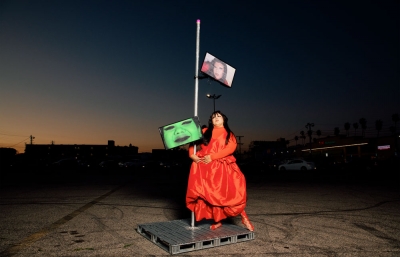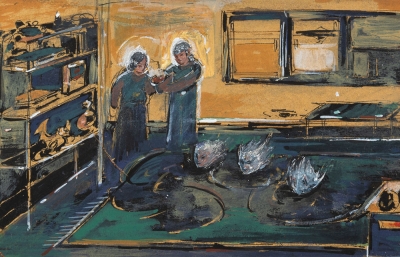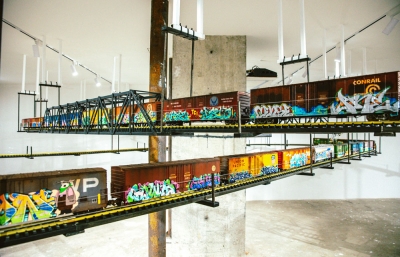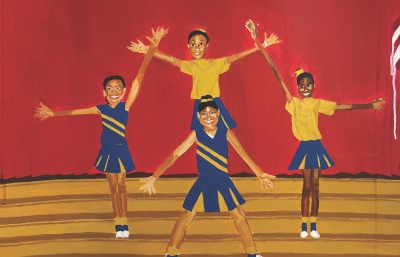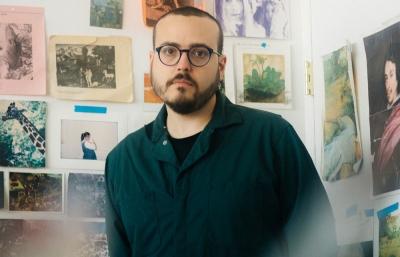Street Art, by its very name, almost defies definition. For years, the formula of, “Let’s put art from the streets into a gallery, but what is it?” has been a legit discussion, but rarely do we view it from the other end by considering what happens when an artist takes a gallery practice and brings it into the street, transforming our perception of public space.
Using words and LED light sculptures to create political interventions in urban areas and natural landscapes, Scottish-born, London based artist Robert Montgomery balances the intimate and ethereal characteristics of prose and poetry, forging them into a fine art practice and a poetry imprint, New River Press. By placing his artwork in situations where advertisement-speak dominates language, Montgomery actively amplifies his art, inspired by some of the great wordsmiths and thinkers of the twentieth century. After his participation at Nuart 2016 in Norway, we sat down in his London studio and considered Bob Dylan, the idea of permanence, and the power of good street art.
Read this feature and more in the February 2017 issue of Juxtapoz Magazine.
Evan Pricco: When I disconnect you from ownership of the work, this sort of anonymous, whimsical spirit emanates from your poetry. Some just feel like they don’t have an author and exist as quotes from time. And then you have works that feel so personal and direct, especially the wheatpastes. Both these methods are impactful. Does that observation resonate at all with you?
Robert Montgomery: I’m definitely conscious of them being slightly different voices, for sure. At the beginning of my career, I decided that I would do this mix of statements that were political and some that were personal or romantic. I would go from more authoritative observations of the state of the world to things that were almost addressing a lover. So you get this voice of describing the collective state of the “things,” and then you have the interior voice of something quite personal.
What I studied most in terms of getting that voice, which is topical because he was just awarded the Nobel Prize in Literature, was Bob Dylan. You can learn so much from studying the way Dylan treats pronouns. On the album Blood on the Tracks, the way he does the simple trick of switching “me” and “him,” and “you” and “she” changes how you address or view the subject. It’s a really clever device. It’s one of those things where you can study a hundred years of great literature to find out how to do it, but then, Dylan does it best.

There was that era, right? That heyday of modern writing, where there was just such great experimentation of literary voice and narrative.
There are so many great writers and poets who make every word count. John Ashbery wrote this brilliant poem in the 1970s called So Many Lives, which starts off with this great lead, “Sometimes I get radiant drunk when I think of and/or look at you,/ Upstaged by our life, with me in it./ And other mornings too/Your care is like a city, with the uncomfortable parts/Evasive, and difficult to connect with the plan/That was...” What I love about this kind of poetry is that mix of romantic and ordinary language. That is something I really like.
I’m glad you brought up Dylan, because what I always appreciated about his singular position in the arts is that at one point, he was quite a “pop star,” one who was using complicated language techniques but still reached a wide audience. That is rare and doesn’t quite exist in popular music today. Perhaps you could look to Kendrick Lamar as probably the most popular artist with that strong command of language.
“The ghost of electricity howls in the bones of her face, where these visions of Johanna have now taken my place.” Incredible stuff. I have this theory that this period for Dylan, like 1965-68, is amphetamine writing. And this sort of wild poetry, this imagist way, is just beautiful.
In terms of authorship, often when an author writes something or publishes a piece of fiction, people will assume that this is the author’s truth. Which isn’t always the truth because, if you are good writer, you can balance story-making and personal experience. Can I assume, for your art, that you come from a place of truth?
I would say it’s pretty much what I think. I like to sort of stay in the first person, but having said that, sometimes I try and think about the collective conscious, though sometimes they just unfold. When I started doing street work in 2004, I did a whole series of anti-war poems, and these just sort of came out and wrote themselves. It wasn’t just what I was feeling; it was what everyone was feeling. And they came out of being part of the anti-war movement and going on amazing peace marches around London in 2003. So it was responding to how everyone around me was feeling.

Nuart 2016, Photo by Ian Cox
Do you find that people often ask, “Well, Robert, what do you mean by this?”
Actually, the question I get the most is, “Are you an artist or a poet? Is this art or is this poetry? What is it?”
Categories make people feel comfortable.
I’m not so into that. I think if you are really secure in what genre you belong, you are probably not saying anything all that new. I don’t know what genre I fit into...
If you decide whether to do a light piece or a simple black-on-white text wheatpaste or poster, does the message change at all?
It’s definitely harder to write the light pieces, just the actual schematics of having to write in brief. Also, I’m an artist using poetry as opposed to a poet who became an artist, so I definitely think in graphic terms first. A billboard has to have a certain length to make it work graphically. So there is definitely this struggle to condense the phrasing to make it work economically and graphically. I’ll start with maybe 200 words and edit down.
Did you study graphic design?
No, actually, I studied painting.

Nuart 2016, Photo by Ian Cox
Tell me how the career path evolved in this direction. When you went to study painting, did you go in with the focus of becoming an exhibiting artist?
I studied painting at the University of Edinburgh in Scotland, which is a very traditional art school. And I think I went into painting with the idea that I was going to be an expressionist painter—like Egon Schiele or something. And then I started working with text at the end of school, and did installation work for my BA show. During my MFA, I did a project with a classmate of mine called Aerial where we went to the Scottish Arts Council and applied for a grant so we could participate in this project that allowed artists to take over advertising space— intervene with the advertising in the city, really. We got the money to do it, and this was the first time I actually got to work on the street and in the advertising space, and also facilitated others artists in the same way. In the end, I think I’m the only artist from that project that made working in this arena, this advertising sort of venue, their careers.
So this triggered something in you, realizing this is the space where you wanted to explore and work?
It triggered something because that whole project was inspired by Jenny Holzer. I thought she was a fucking genius. I just loved the therapy of taking over advertising space.
Advertising is also the stripping away of language, simplifying language down to something so universal that surpasses words. You are re-examining that space.
I read a lot of language theory at university, and specifically, Roland Barthes, whose theory that all types of speech were inherently political because of the commonality of ideas that a certain way of speaking implies. Advertising speech for example, treats us only as consumers, as one-dimensional beings. Whereas news speech, like CNN, only treats us as a demographic or a potential vote. Put them together, and they are both rooted in the materialist world, and completely excluding anything that is spiritual or counter-political. It’s been ramped up in recent years, and the internet is the pocket version. These places that you get your news, Google or Facebook, are just advertising companies.
And the companies that advertise with them get a better chance to “reach their audience” because they are the only ones who can afford to open the paygate of access. Pay to be the top Google search, pay to reach more Facebook followers. I know we may seem to be wandering away from art talk, but your work is finding ways for art and poetry to occupy a space that is being made increasingly inaccessible from language.
At the same time, the internet has this sort of supernatural aspect of instantaneous information from a distance. Like NYC to London in a second. It’s a positive thing, but it’s really supernatural. If you told someone in 1916 about what was to come in 2016, they would say it was wizardry. And what is frightening to me is that we are all sort of bored of this now, with these new powers that we have. We chase the sunset on a airplane from London to NYC, flying at 35,000 feet, and complain about the chicken we’re eating. You are a mammal, flying in the space of angels and birds and eating the soul of a dead bird. It’s like, “You spoiled fucking mammal.”

Nuart 2016, Photo by Ian Cox
Right now, there are a ton of of topics for you to call on for your art. Every era says that, but something about the information superhighway we live in now has really accelerated it all. Is that overwhelming?
Yeah, and it gets a bit depressing to write about it. That is why it’s important to have the romantic stream in the work because you can retreat into that and perhaps not just focus on the bad. What’s nice is that when I work on a public project, like the one for Cardiff, Wales right now, is that curators aren’t necessarily asking you to inject politics into the work. And I’m interested in that. I’m working on a permanent piece with a public arts council in Cleveland. I may have something perhaps in the works with a new Holocaust museum here in London. So I like the idea of doing permanent projects, works that will be somewhere for a long time. The work then becomes a delicate balance of tone and universality, and you don’t focus on being partisan, which makes it more interesting, really.
You spoke of your enjoyment in being included in street art festivals, and that it was a welcome development.
I really like the energy of street art. In a way, that energy is at the core of what I do. I get confused when I hear accounts of other contemporary artists not wanting to participate in street art festivals. I always get a really uplifting sense of energy from them and a sense of freedom. I often feel a lot more spiritually in-tune with street artists. I think my perspective is that the kind of contemporary art I'm closest to, like that of Jenny Holzer, Lawrence Weiner, or Ann Messner, has a shared origin with graffiti art. I think if you go back to the early 1980s in New York and shows like The Real Estate Show and The Time Square Show, you can see that origin, you see conceptual artists and graffiti artists being part of the same movement. John Ahearn from Colab, who organized The Times Square Show in 1980, said, “There has always been a misdirected consciousness that art belongs to a certain class or intelligence. This show proves there are no classes in art, no differentiation”
I believe in that possibly Utopian idea of classlessness. I think the Nuart Festival in Norway is a really good example, where street art is part of a more complex and academic history. Martyn Reed, the founder and curator of Nuart, has that expanded vision of what street art is and can be. There's a book that, for a long time, was out of print but was recently reissued called The Writing on The Wall, by Roger Perry, which documents the text graffiti of London in the 1970s. It records the often surrealist text graffiti that grew in London around the 1970s squat scene. As we were preparing to work together for Nuart, Martyn and I realized this book had been an inspiration both to him becoming a street art curator and to me in becoming a text artist—now there's a perfect example of shared origins and shared cultural histories.
What have you been most excited to explore in recent months? The light poems? The billboards? What you did in China was really stunning, and Cardiff as well.
The piece I did for the Yinchuan Biennale was certainly my biggest piece of the year, it was 150 meters long and spanned a whole river bridge outside the museum. I really enjoyed it and worked with a great team at the Cardiff Contemporary. I think Nuart and The Crystal Ship were both definite highlights of the year for me. I think Martyn Reed and Bjørn Van Poucke are both pushing the boundaries of what public art festivals can be, and I'm really interested in the way they're approaching that question. I also really enjoyed working with Barbara Polla and Paul Ardenne on the Anglet Biennale, and I managed to do my first light piece in French, without, I hope, losing too much in translation. I also set up a small poetry press with Greta Bellamacina, which is called New River Press. We're looking at it almost as an indie music label for poetry.

Cardiff Contemporary, Cardiff, Wales, 2016
That line "All Palaces Are Temporary Palaces" really resonates with me, especially now as this idea of temporary power seems like a desperate feeling in America. Does that happen to you often, where you write a poem or a line and it takes on a new life long after the project has passed?
Yes, it does, especially when things begin to slide towards increased xenophobia, misinformation and selfish short-termism, which I think is what has happened in Britain with Brexit and the US with Trump. I wrote a billboard piece in 2011 that has come back to haunt me in the days after Trump's victory. It contains the line, "here comes the white working class again." At the time, I imagined the voice of the white working class gathering behind someone like Michael Moore or Bernie Sanders, I did not imagine the white working class would be fooled into a vote for someone like Trump. I think, for all of us here in Europe with a sense of historic memory, it is frighteningly reminiscent of the beginning of the rise of fascism. I hope we are able to amplify the voices of people like Michael Moore and Bernie Sanders as an affirmation over the next four years to bring some sense and kindness back into the argument.
----
Originally published in the February 2017 issue of Juxtapoz Magazine, on newsstands worldwide and in our web store.

![Portrait by Fabio Paleari of Robert Montgomery with fellow poets from New River Press. [Left to right: Rosalind Jana, Greta Bellamacina, Hearthcote Williams, Robert Montgomery, Niall McDevitt]](/media/k2/galleries/63226/00_2780207-1.jpg)





















